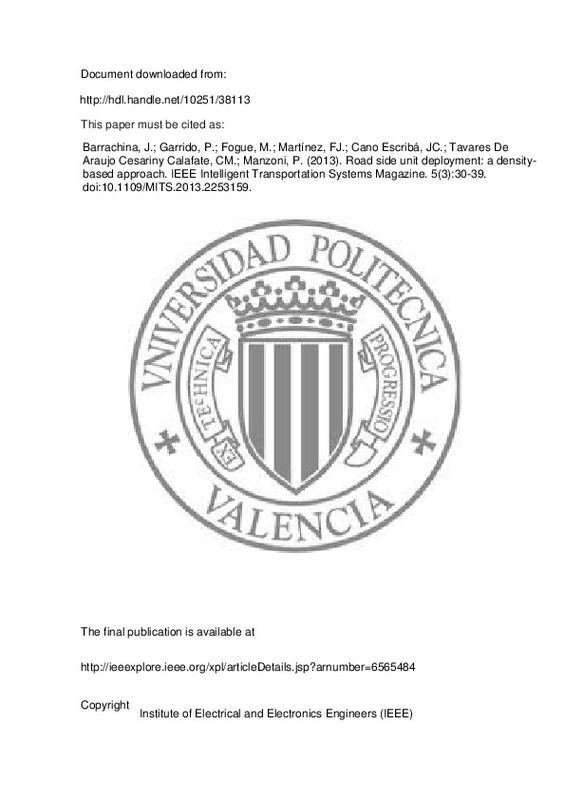Barrachina, J.; Garrido, P.; Fogue, M.; Martínez, FJ.; Cano Escribá, JC.; Tavares De Araujo Cesariny Calafate, CM.; Manzoni, P. (2013). Road side unit deployment: a density-based approach. IEEE Intelligent Transportation Systems Magazine. 5(3):30-39. https://doi.org/10.1109/MITS.2013.2253159
Por favor, use este identificador para citar o enlazar este ítem: http://hdl.handle.net/10251/38113
|
Título:
|
Road side unit deployment: a density-based approach
|
|
Autor:
|
Barrachina, Javier
Garrido, Piedad
Fogue, Manuel
Martínez, Franciso J.

 Cano Escribá, Juan Carlos
Cano Escribá, Juan Carlos

 Tavares de Araujo Cesariny Calafate, Carlos Miguel
Tavares de Araujo Cesariny Calafate, Carlos Miguel

 Manzoni, Pietro
Manzoni, Pietro
|
|
Entidad UPV:
|
Universitat Politècnica de València. Departamento de Informática de Sistemas y Computadores - Departament d'Informàtica de Sistemes i Computadors
|
|
Fecha difusión:
|
|
|
Resumen:
|
Currently, the number of vehicles increases every year, raising the probability of having accidents. When an accident occurs, wireless technologies enable vehicles to share warning messages with other vehicles by using ...[+]
Currently, the number of vehicles increases every year, raising the probability of having accidents. When an accident occurs, wireless technologies enable vehicles to share warning messages with other vehicles by using vehicle to vehicle (V2V) communications, and with the emergency services by using vehicle to infrastructure (V2I) communications. Regarding vehicle to infrastructure communications, Road Side Units (RSUs) act similarly to wireless LAN access points, and can provide communications with the infrastructure. Since RSUs are usually very expensive to install, authorities limit their number, especially in suburbs and areas of sparse population, making RSUs a precious resource in vehicular environments. In this paper, we propose a Density-based Road Side Unit deployment policy (D-RSU), specially designed to obtain an efficient system with the lowest possible cost to alert emergency services in case of an accident. Our approach is based on deploying RSUs using an inverse proportion to the expected density of vehicles. The obtained results show how D-RSU is able to reduce the required number of RSUs, as well as the accident notification time.
[-]
|
|
Palabras clave:
|
Emergency services
,
Mobile radio
,
Road accidents
,
Wireless LAN
|
|
Derechos de uso:
|
Reserva de todos los derechos
|
|
Fuente:
|
IEEE Intelligent Transportation Systems Magazine. (issn:
1939-1390
)
|
|
DOI:
|
10.1109/MITS.2013.2253159
|
|
Editorial:
|
Institute of Electrical and Electronics Engineers (IEEE)
|
|
Versión del editor:
|
http://ieeexplore.ieee.org/xpl/articleDetails.jsp?arnumber=6565484
|
|
Código del Proyecto:
|
info:eu-repo/grantAgreement/MICINN//TIN2011-27543-C03-01/ES/WALKIE-TALKIE: SOPORTE A ENTORNOS DE TRANSPORTE SEGURO, INTELIGENTE Y SOSTENIBLE PARA LA FUTURA GENERACION DE COCHES INTELIGENTES/
|
|
Descripción:
|
© 2013 IEEE. Personal use of this material is permitted. Permission from IEEE must be
obtained for all other uses, in any current or future media, including
reprinting/republishing this material for advertising or promotional purposes, creating new
collective works, for resale or redistribution to servers or lists, or reuse of any copyrighted
component of this work in other works.
|
|
Agradecimientos:
|
This work was partially supported by the Ministerio de Educacion y Ciencia, Spain, under Grant TIN2011-27543-C03-01, as well as by the Fundacion Universitaria Antonio Gargallo (FUAG), and the Caja de Ahorros de la Inmaculada ...[+]
This work was partially supported by the Ministerio de Educacion y Ciencia, Spain, under Grant TIN2011-27543-C03-01, as well as by the Fundacion Universitaria Antonio Gargallo (FUAG), and the Caja de Ahorros de la Inmaculada (CAI).
[-]
|
|
Tipo:
|
Artículo
|







![[Cerrado]](/themes/UPV/images/candado.png)


